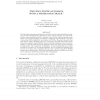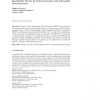426 search results - page 40 / 86 » Synchronization of Regular Automata |
JALC
2007
13 years 7 months ago
2007
The basic finite automata model has been extended over the years with different acceptance modes (nondeterminism, alternation), new or improved devices (two-way heads, pebbles, ...
ARITH
2007
IEEE
14 years 2 months ago
2007
IEEE
An emerging nanotechnology, quantum-dot cellular automata (QCA), has the potential for attractive features such as faster speed, smaller size, and lower power consumption than tra...
SIGCSE
1997
ACM
13 years 12 months ago
1997
ACM
We present a collection of new and enhanced tools for experimenting with concepts in formal languages and automata theory. New tools, written in Java, include JFLAP for creating a...
ACTA
2010
13 years 8 months ago
2010
Systems of Data Management Timed Automata (SDMTAs) are networks of communicating timed automata with structures to store messages and functions to manipulate them. We prove the dec...
CPAIOR
2009
Springer
14 years 2 months ago
2009
Springer
An attractive mechanism to specify global constraints in rostering and other domains is via formal languages. For instance, the REGULAR and GRAMMAR constraints specify constraints ...


